Seasons – May 2021
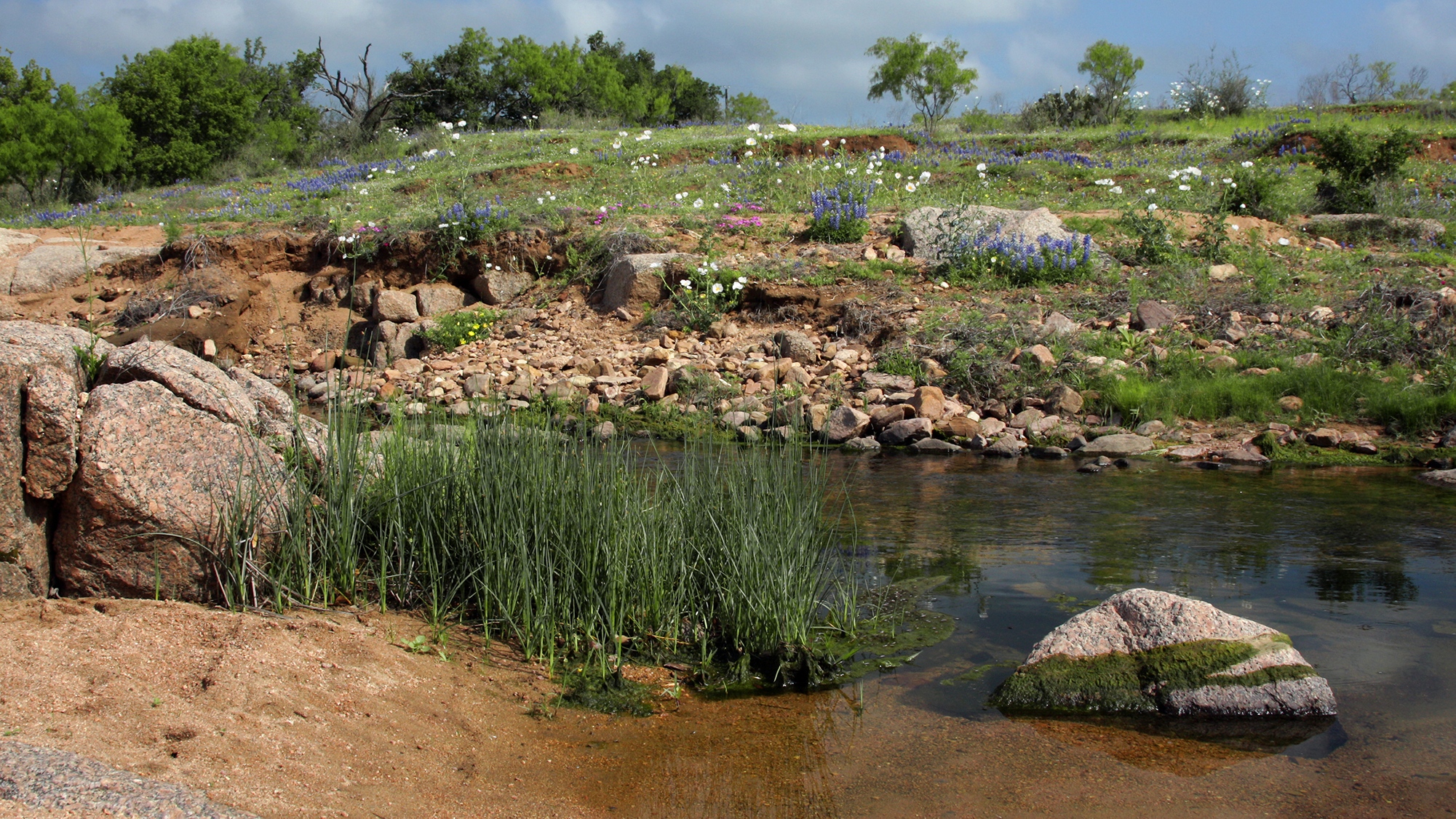
From the Plateau Land & Wildlife Management Team
Summer is right around the corner, and while we’re preparing ourselves for the heat we must also remember how rising temperatures can affect our land and the wildlife on it. In this issue of Seasons, you’ll find articles about creative ways to keep water on your property this summer, supplemental water activities for wildlife, upcoming webinars for landowners, and more!
We hope you enjoy the read and everything this summer has to offer, and if there’s any way Plateau can help you protect, enhance or better enjoy your land during this special season, just give us a call. We’ll be here when you need us.
Until next Seasons,
The Plateau Team
Table of Contents
Creative Ways to Increase Water Retention on Your Land
Wildlife Management Activity Reminder: Supplemental Water
Service Spotlight: Getting Started in Wildlife Management Webinar
Braun & Gresham Landowner 101 Webinar Series
Plateau Land Group: Rural Real Estate Services for Landowners
Field Notes: Pictures & Highlights of Properties in Wildlife Management
News for Texas Landowners
Creative Ways to Increase Water Retention on Your Land
By Beyrl Armstrong, Co-Founder of Plateau Land & Wildlife Management
Water gives life to the natural world. Without water, soils become dirt, plants perish, and animals vanish. Other than water stored in lakes and rivers, rainfall is the only source of life-giving water.
In Texas, the amount of water that falls on a particular piece of property varies greatly depending upon its geographic location. The Piney Woods of East Texas can receive 50-60 inches of rain in a year while the deserts of West Texas can barely count on 8-10 inches of annual rainfall. Annual rainfall in the rest of Texas falls between these two extremes. The amount of water that is available through rainfall on any given piece of property can be referred to as the “water budget” of that property. In order for landowners to establish what the water budget is on their property, they need to first understand where their property lies geographically in Texas. The map below, created by the Texas Water Development Board, illustrates the average yearly rainfall by county in Texas.
Once the amount of rainfall (the “income” in the water budget) is determined, then a landowner can begin to plan for the best way to manage that budget.
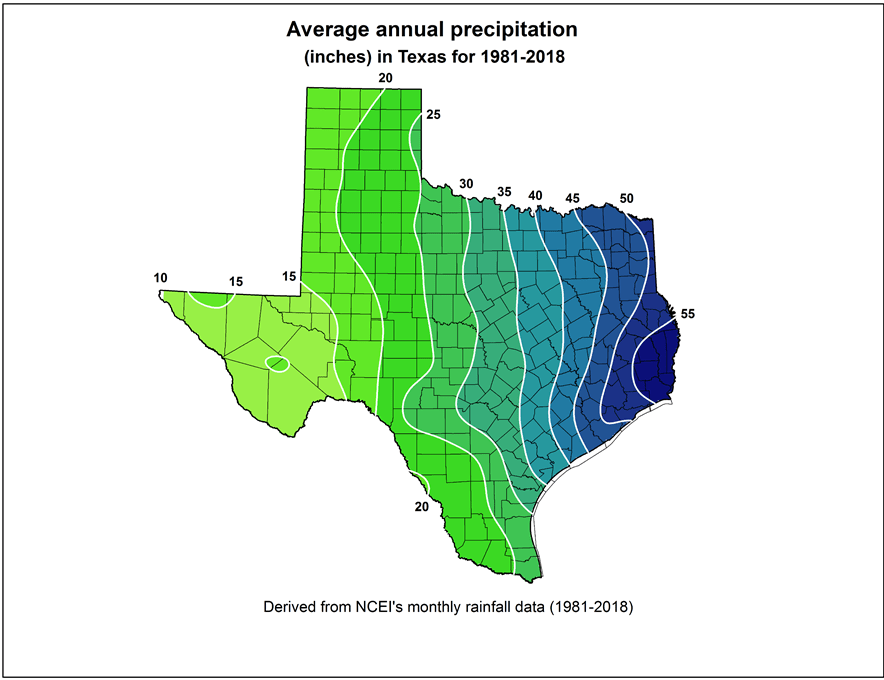
Considerations for Water Retention
Like all budgets, the income must be balanced against expenses. Savings accounts should be developed to protect against variances in income and increases in expenses. In order to devise an effective water budget, it is important to understand the things that affect the amount of water that can be retained from the original rainfall input. These “expenses” are:
- Evaporation – the return of water to the atmosphere from the surface of leaves, bare ground, water bodies, and impervious surfaces (roofs, roads, etc.).
- Transpiration – the exhausting of moisture from plants and animals.
- Interception – plant cover that does not allow for rainfall to reach the ground and is a source of both evaporation and transpiration.
- Runoff – the flow of water across the surface of the land.
Water retention can be considered the “savings account” in the water budget. Water can be retained in ponds and lakes, wetlands and marshes, moist soils, and, ultimately, by infiltration that may eventually recharge aquifers for underground storage.
The illustration below shows how the “Water Cycle” works. Inputs from rain are balanced against evaporation, transpiration, runoff, infiltration, and recharge.
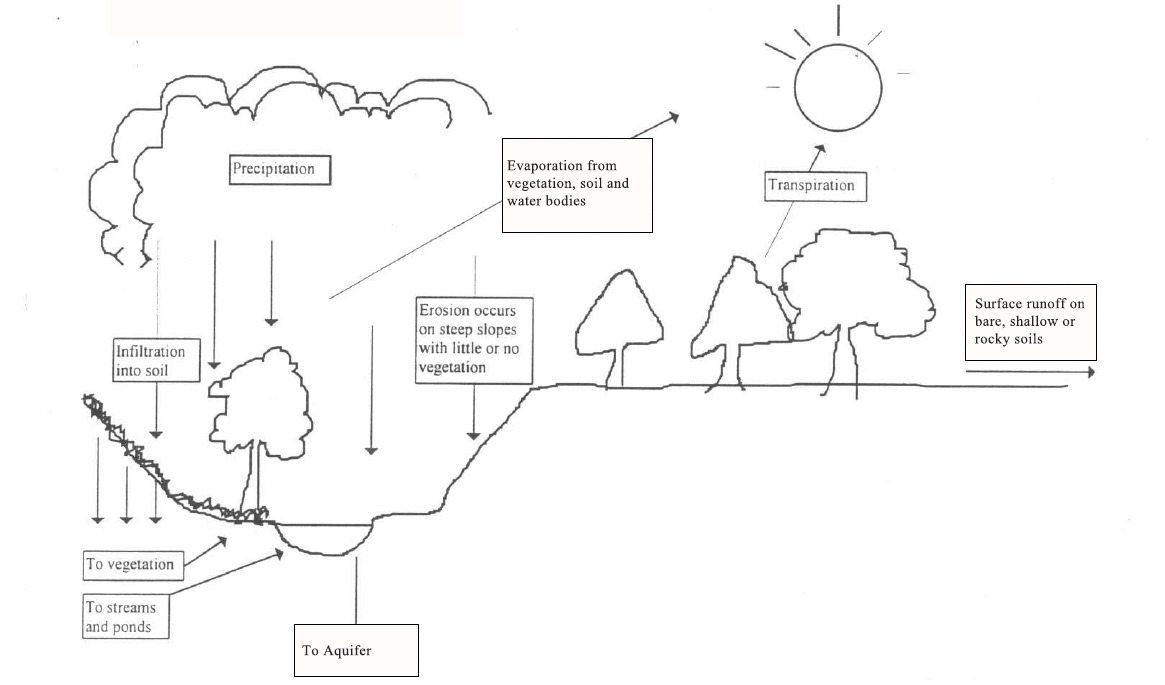
Things to consider when managing land to maximize the retention of water are:
- Local climate – humidity levels affect evaporation rates.
- Aspect – the relationship of a property to the sun, i.e., west, and south-facing slopes have a higher evaporation rate and are drier than east, and north-facing slopes.
- Slope angle – steep slopes can allow for more runoff and less infiltration.
- Impervious cover – exposed rock, hardened soils, roads, and rooftops.
- Plant Cover – density and types of plants that are located on the property.
Now that the planning parameters have been established, it’s time to come up with a water budget for a sample piece of property:
Let us say that a landowner has a 60-acre piece of property located in Blanco County. The terrain is rolling hills with an intermittent creek flowing through the middle of it. Along the creek are flat, deep-soiled “benches”. Most of the hills are south facing and the hilltops have very shallow, rocky soil. According to the map above, the average rainfall for the area is 30-35 inches per year. The climate is moderately humid.
In order to maximize water retention on the property, the best approach would be to increase infiltration by slowing the flow of water across the deep soil areas along the creek and on the hilltops and decreasing runoff from the hills intercepting rainfall on the steeper slopes. The runoff of water in the intermittent creek could be decreased during high volume rain events by the establishment of trees and woody shrubs within and along the banks of the creek.
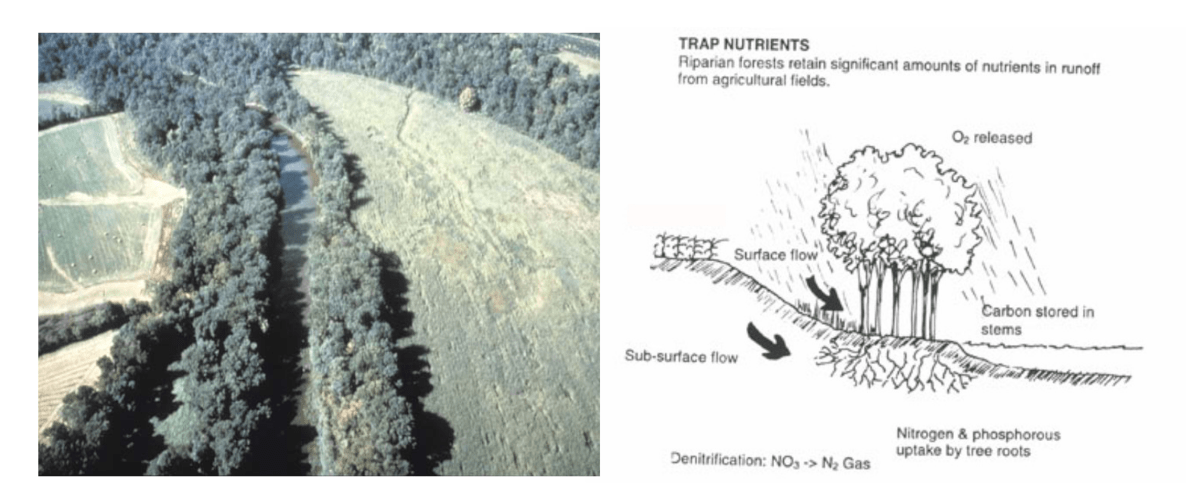
Photo and graphic provided by the Natural Resources Conservation Service. On the left shows a riparian corridor with trees along the banks to slow the surface flow of water. On the right shows how nutrients are trapped in the ground when you slow surface flow.
With these management parameters in mind, how would the landowner actively manage the property to achieve these goals?
- Reducing grazing pressure on the hilltops and creek sides would allow for tall grasses to grow, slowing the flow of water across the land, thereby improving infiltration.
- Planting a diverse blend of native grasses and perennial forbs (wildflowers) could help speed up infiltration.
- Allowing trees and shrubby plants to grow on the steep slopes would increase interception of heavy rainfall and allow it to slowly move through the leafy vegetation and be absorbed in the ground beneath the woodlands. Some water, captured by the bark and leaves of the trees would be infiltrated into the soils through stem flow within the trunks of the trees. Evaporation rates would be reduced by the increased shade provided by the woodlands on the slopes and the tall grasses covering the shallow soils on the hilltops.
- The planting and natural recruitment of trees and woody plants along and within the banks of the creek would both provide shade to reduce evaporation of any standing water in the creek and, with the presence of roots and trunks, slow water flow during heavy rains and facilitate the development of gravel beds that would act as small dams, creating more permanent pools of water within the creek bed.
Once these practices are established, periodic management of the grasslands by short-term grazing, mowing, and/or the application of prescribed fire will be needed to maintain them. The wooded areas will be self-tending.
These management practices not only help increase the infiltration and retention of water, but they also provide habitat for wildlife and are aesthetically pleasing. It takes patience for landowners to manage their land to slowly become a natural sponge. Planting native grasses can be expensive and natural recruitment of woody plants takes time. However, the benefits to the water budget, wildlife, and the pride of ownership make these management practices very much worthwhile.
Have questions about improving the water retention on your land? Please contact us at [email protected] or (512) 894-3479.
Back to TopBack to Top
Wildlife Management Activity Reminder: Supplemental Water
By Kameron Bain, Landowner Account Manager
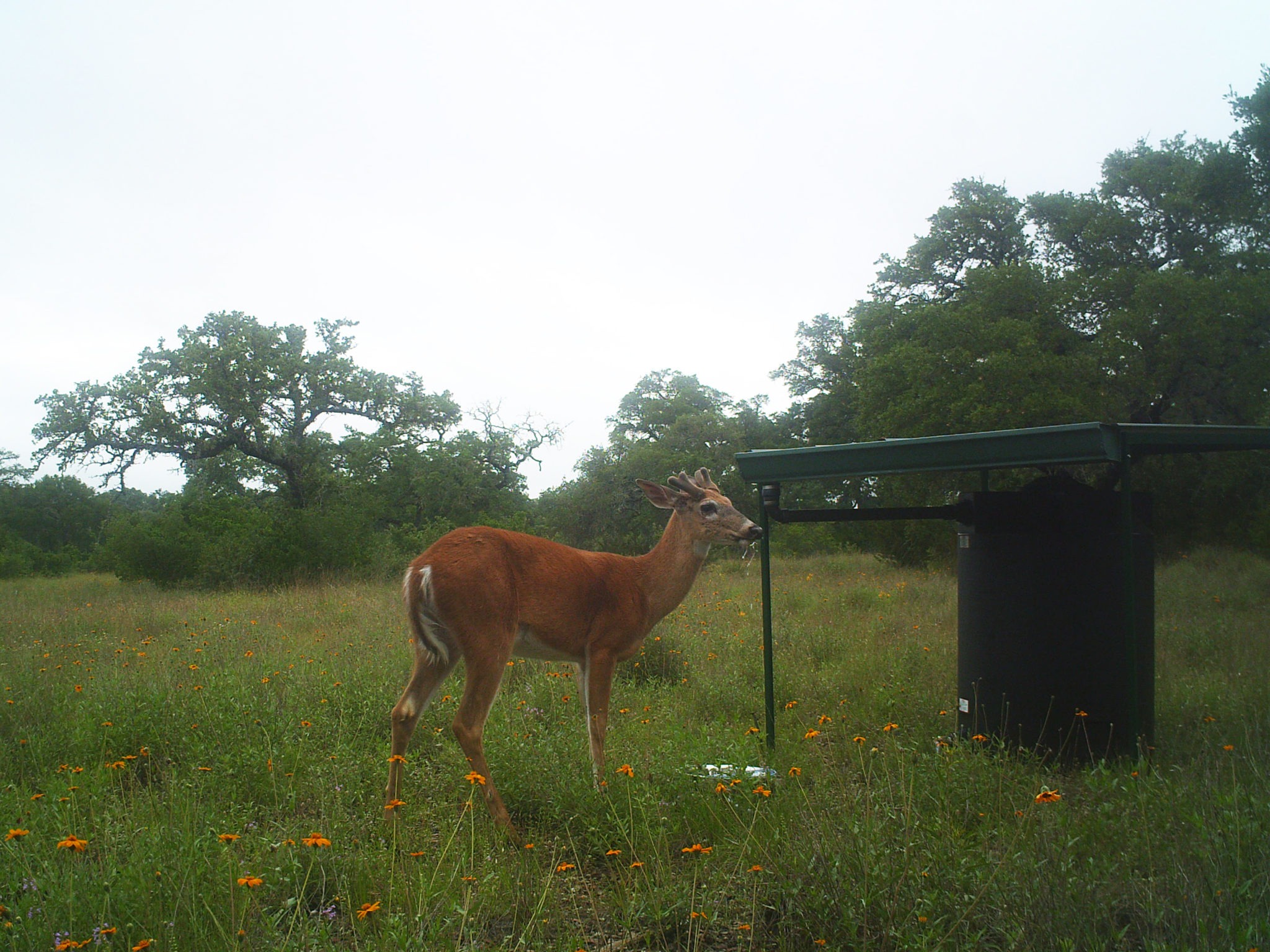 Water is good for every target species, from pollinators like butterflies and bees to larger animals like Wild Turkey and deer. Wildlife can acquire water through three sources: free water, food, and metabolic water. Free water is any water wildlife may drink – from dew to puddles, to a flowing creek. Food provides water in varying amounts, e.g. a fresh grasshopper or fruit provides more water than dried seeds or twigs. Metabolic water is water created inside the body as a by-product of cellular respiration, and many species rely heavily on this source, particularly in arid environments.
Water is good for every target species, from pollinators like butterflies and bees to larger animals like Wild Turkey and deer. Wildlife can acquire water through three sources: free water, food, and metabolic water. Free water is any water wildlife may drink – from dew to puddles, to a flowing creek. Food provides water in varying amounts, e.g. a fresh grasshopper or fruit provides more water than dried seeds or twigs. Metabolic water is water created inside the body as a by-product of cellular respiration, and many species rely heavily on this source, particularly in arid environments.
The wildlife water source landowners can have the most direct, year-round impact on is free water. Good land management helps reduce runoff and puts water into our aquifers, where it may come up as springs to feed our creeks and rivers. Healthy wetlands and riparian habitats alongside streams help store water for more reliable flows.
Both spring enhancement and wetland creation qualify under Supplemental Water. Note that while these are natural water sources, there is an activity in the enhancement or creation. In contrast, having an existing stock tank or pond that is filled by runoff requires no activity on your part, so it does not qualify under Supplemental Water. Constructing a new pond or repairing or enhancing an existing one can qualify under other categories.
For areas on your property that have no natural water, providing artificial water sources through an existing well or livestock trough makes for an easy activity. Setting troughs at ground-level or building a ramp from rocks, wood, or hog panel makes any source wildlife-friendly. Be sure to run it from the inside-bottom, over the edge, and down to the ground outside to grant access to small wildlife and keep them safe from drowning. If you need a new trough, keep in mind that small troughs or pans lose less water to evaporation and cost less than larger livestock troughs.
That’s why we use metal dog pans on our water tables, which is another option for providing water in dry places. No well, no problem. Catch rain on a roof and store it in a cistern or water tank connected to a small pan or trough. This can be particularly good for improving water distribution on your property. Ideally, you should provide a source of free water every quarter to a half-mile across your property, though bigger properties managing for large animals such as deer or Wild Turkey can spread them out farther.
Take new pictures each year of your water sources or water-related activities for your records and annual report.
What qualifies?
- Rainwater collection systems like Plateau’s Water Tables and Quail & Small Wildlife Feeding and Drinking Station
- Modified livestock troughs with wildlife-friendly ramps offering safe access for target species – these may be filled automatically or manually as long as the water is reliable
- Well or windmill flow into artificial or earthen holding tanks at ground-level
- Natural spring enhancement/development
What does not qualify?
- Man-made lakes and ponds supplied only by overland flow or natural springs
- Rivers, creeks, streams, etc. that are natural sources (not a supplement but they are great for wildlife)
For questions about your supplemental water activity, or if interested in purchasing a Plateau Water Table or Wildlife Station contact us at [email protected] or (512) 894-3479
Service Spotlight: Getting Started in Wildlife Management Webinar
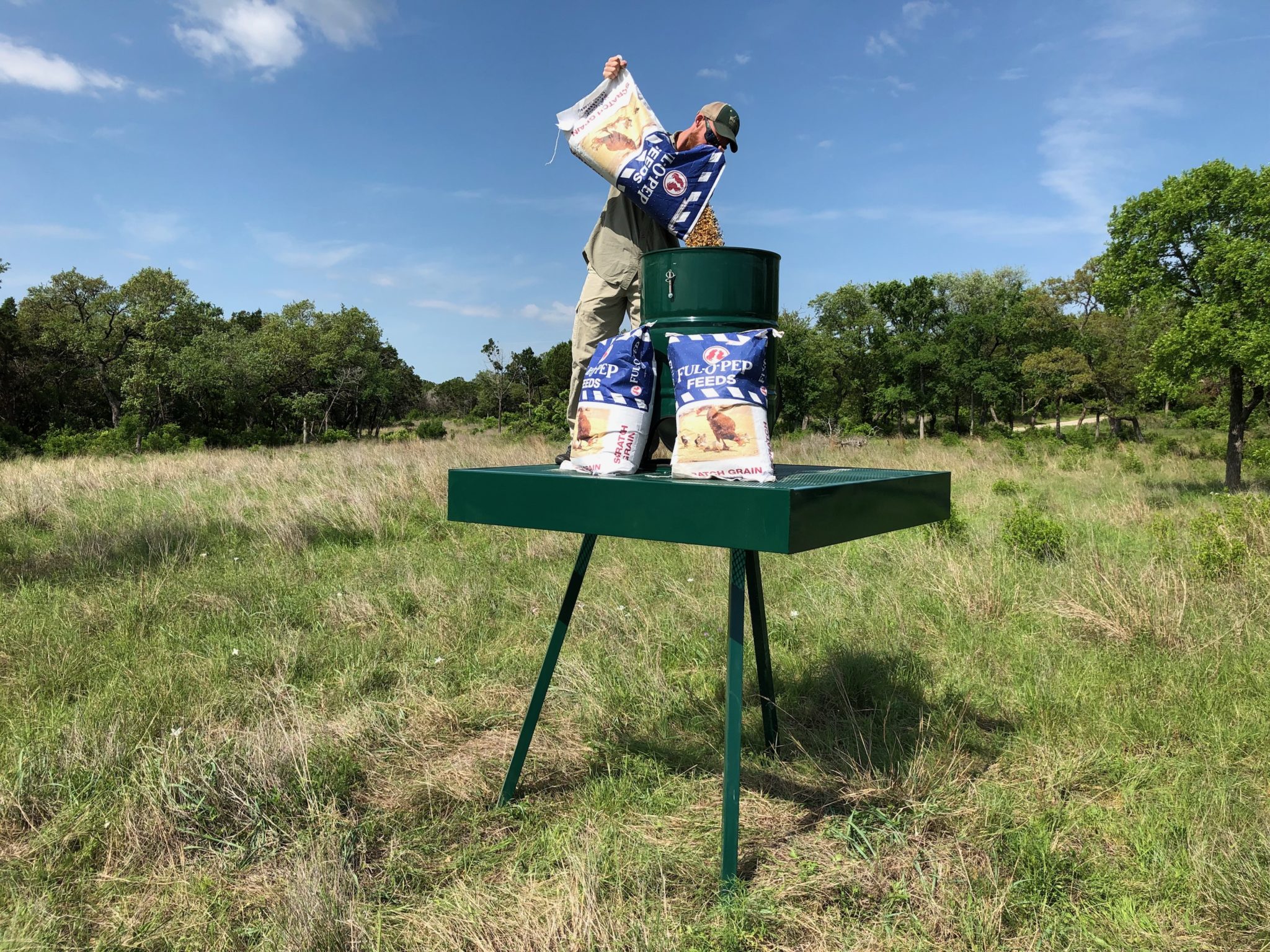 Join us this May to learn how to get started with your Wildlife Management activities!
Join us this May to learn how to get started with your Wildlife Management activities!
Whether you’re new to Wildlife Management or have been in it for years, we want to be here to help address your questions about appropriate activities and record-keeping strategies. Join us on Tuesday, May 11th, from 6:00 – 7:00pm for a FREE webinar benefiting anyone who currently has a wildlife exemption.
This webinar will provide a review of the seven activity categories, how to implement and document those activities, provide examples of common practices, and discuss how Plateau can help. During this one-hour webinar, time will be provided to address your questions.
To register, visit: https://us02web.zoom.us/webinar/register/WN_EoG6qGEZScqACBCNdg-rKg
If you have questions or need assistance registering for a webinar, please contact us at (512) 894-3479 or email [email protected].
Back to TopBack to Top
Braun & Gresham Landowner 101 Webinar Series
Check back for new topics this May in Braun & Gresham’s Landowner 101 webinar series! Watch free webinars covering important laws and legal considerations for landowners. This webinar series will benefit anyone who owns rural land in Texas.
Upcoming topics include:
- Creative Ways to Deal with Neighbor Disputes – May 4th
- Tips for Navigating Property Tax Protests – May 11th
- Tools to Limit Your Risk & Protect Your Land – May 18th
- Top 5 Legal Considerations for Small Businesses – May 25th
Can’t make it to a live webinar? No problem. You can watch past webinar recordings by visiting: https://braungresham.com/past-webinars/
Braun & Gresham, PLLC provides a wide range of legal services to meet the needs of landowners, whether ranchers, farmers, non-profits, businesses, or individual clients. These webinars highlight key challenges many landowners face, and will educate you about the various tools available to address those challenges and achieve an ultimate vision/goal for your property.
For more information about the webinar topics, or assistance registering, contact (512) 894-5426 or email [email protected].
Back to TopBack to Top
Field Notes: Pictures & Highlights of Properties in Wildlife Management
Ever wonder how Wildlife Management is benefiting landowners’ property and the wildlife that lives on it? Here are some photos and highlights, from Plateau’s field staff and game cameras, of successes and small victories our landowner customers are seeing on their property.
Enhancing Natural Water Features
If you have a spring or creek, or natural body of water on your property, some of the best management practices for these areas are to leave them as untouched as possible! Consider fencing off this area from grazing livestock or exotics, and allow the native grasses, shrubs and trees to grow around it. This particular photo shows a spring that has natural vegetation around it, providing shade to reduce evaporation and form a small pool on the landowner’s property.

Blue Heron Caught on Game Camera
When you think of game cameras, capturing deer and predators on your property often comes to mind. However, you can sometimes get the pleasant surprise of a photo like this – a shot of a Blue Heron taking off in flight! Placing game cameras on your property not only counts as a census wildlife management activity, but also gives you insight into the amount and diversity of animals on your property. Plateau can assist with establishing Remote Camera Surveys on your property. To learn more, give us a call at (512) 894-3479!
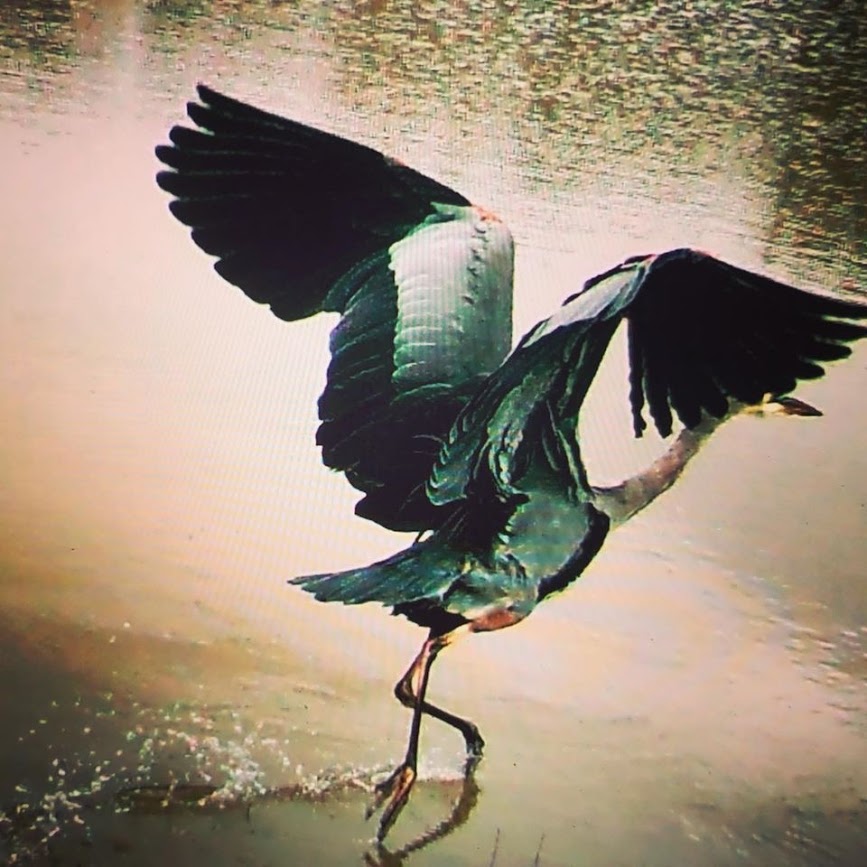
Providing Water for Wildlife
We can’t stress enough the importance of water for wildlife. On a residential property in Hays County, this buck and several does stop by every day to get a drink out of a large water bowl provided on the side of the house. Though it’s most likely not the only water source they have, now that the deer know it’s there and gets re-filled regularly they can rely on it when times get tough. Interested in providing supplemental water for the wildlife on your property, Plateau offers 305 and 100 gallon Water Tables.

So many of you are out there doing great work. We appreciate you, and so do the native wildlife on your property and across Texas. Large or small, you are making a difference. Look for more great examples of wildlife and landowner successes and victories in upcoming Seasons Newsletters!
News for Texas Landowners
Rebecca Springs, Salamander Surveys, and WHY They Matter
Article by Robin Gary with Wimberley Valley Watershed Association
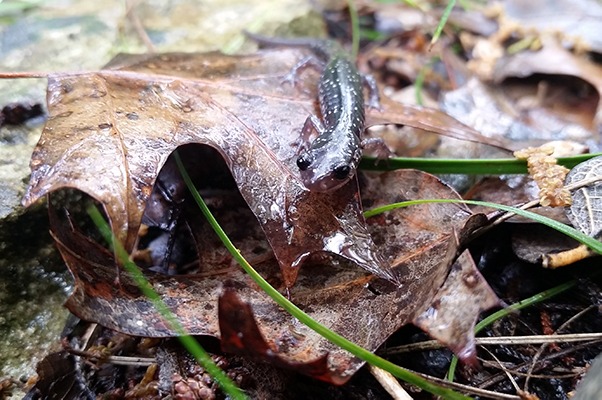
Salamanders are sensitive critters. With external gills and limited habitats, they are good indicators of groundwater health. They rely on clean, clear, flowing springs to maintain healthy populations. Low water levels in aquifers lead to less spring flow and less dissolved oxygen in the water. Pollution and contaminants from surface water runoff can drastically alter water quality. Hill Country residents rely heavily on groundwater, and the status of salamander populations can tell us how well we’re balancing resource protection and development.
The WVWA is helping scientists at the Guadalupe Blanco River Authority, US Fish and Wildlife Service, and Edwards Aquifer Authority survey salamanders and track spring flow and recharge to aquifers in northern Comal County. Rebecca Springs is a Middle Trinity spring that helps provide baseflow to the Guadalupe River and inflows for the Canyon Lake Reservoir…
Managed Lands Deer Program Enrollment is Now Open for 2021-22 Season
News Release by Texas Parks & Wildlife Department
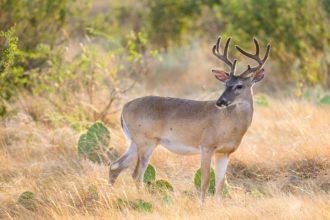
Enrollment in the Managed Lands Deer Program (MLDP) is now open for the 2021-22 hunting season. Open enrollment for the MLDP Conservation Option runs from April 5 through June 15 this year while the Harvest Option opens May 1 and runs through Sept. 1. New this year, fees are being charged for each enrollment option. Enrollments and fee payments can all be made through Texas Parks and Wildlife Department’s (TPWD) Land Management Assistance online system. Payments can be made by credit card only.
MLDP is a program intended to foster and support sound management and stewardship of native wildlife and wildlife habitats on private lands in Texas. Deer harvest is an important aspect of habitat management and conservation. Landowners enrolled in either the MLDP Harvest Option or Conservation Option can take advantage of extended season lengths and property-specific customized harvest opportunities…
Biologists Remind the Public Not to Touch Wildlife
News Release by Texas Parks & Wildlife Department
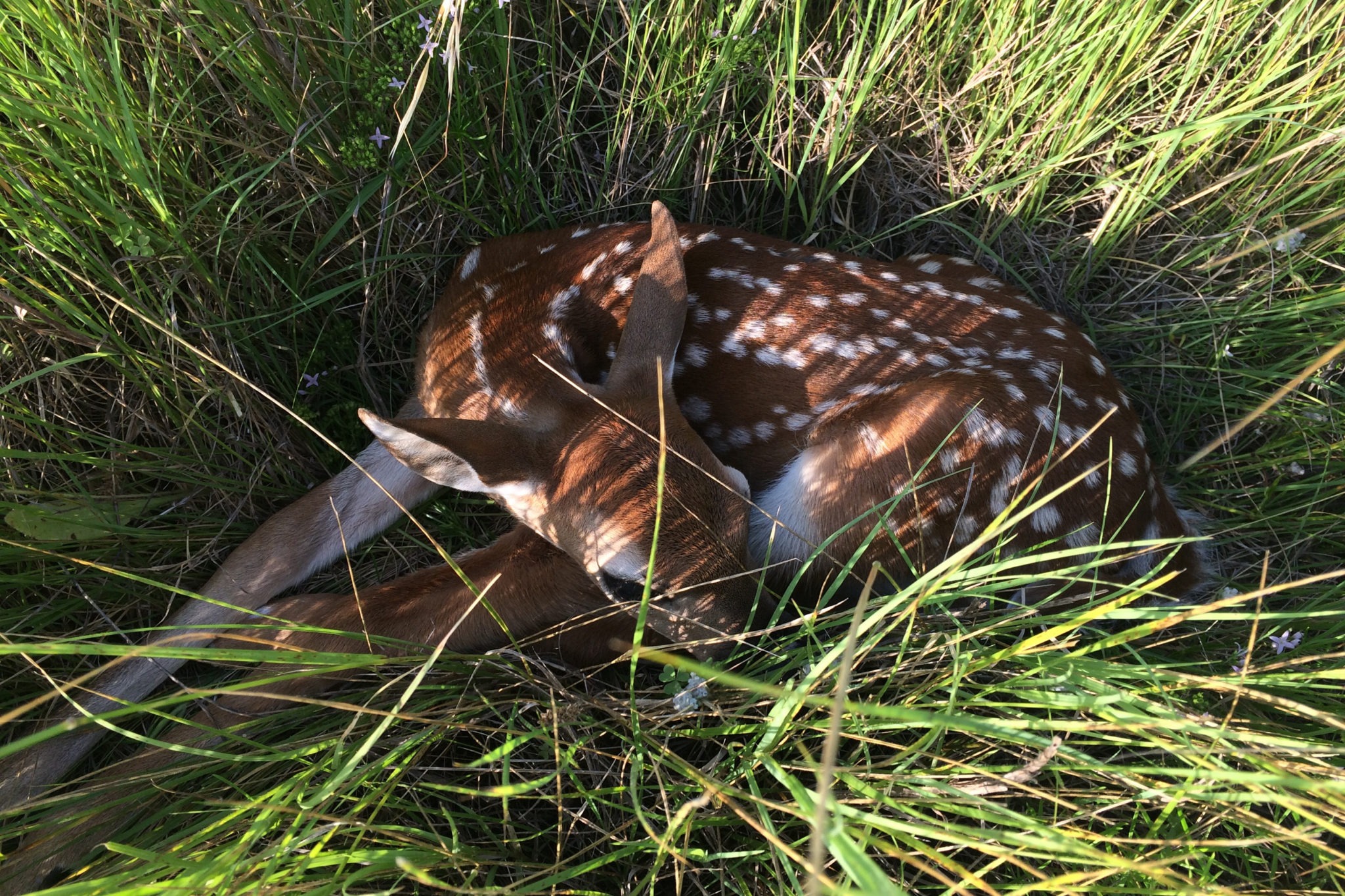
With more people enjoying the outdoors this spring season, you may start to notice more wildlife in your backyard, neighborhood or surrounding areas. Species including birds, deer and snakes are active this time of year and their young often stray or appear to be abandoned. Texas Parks and Wildlife Department (TPWD) experts caution against lending a helping hand.
Animals that are most often picked up by well-meaning citizens are baby birds and deer fawns. However, it is important to realize that many such human-animal encounters are unnecessary and can even be detrimental to the wildlife concerned.
The deer fawning season begins in early to mid-May. A newborn fawn’s mottled coat and mother’s care usually hides them from predators…
Do Thousands of Bat Deaths Mean Texans will Face a Mosquito-Ridden Summer?
Article by Tara Haelle for Texas Monthly
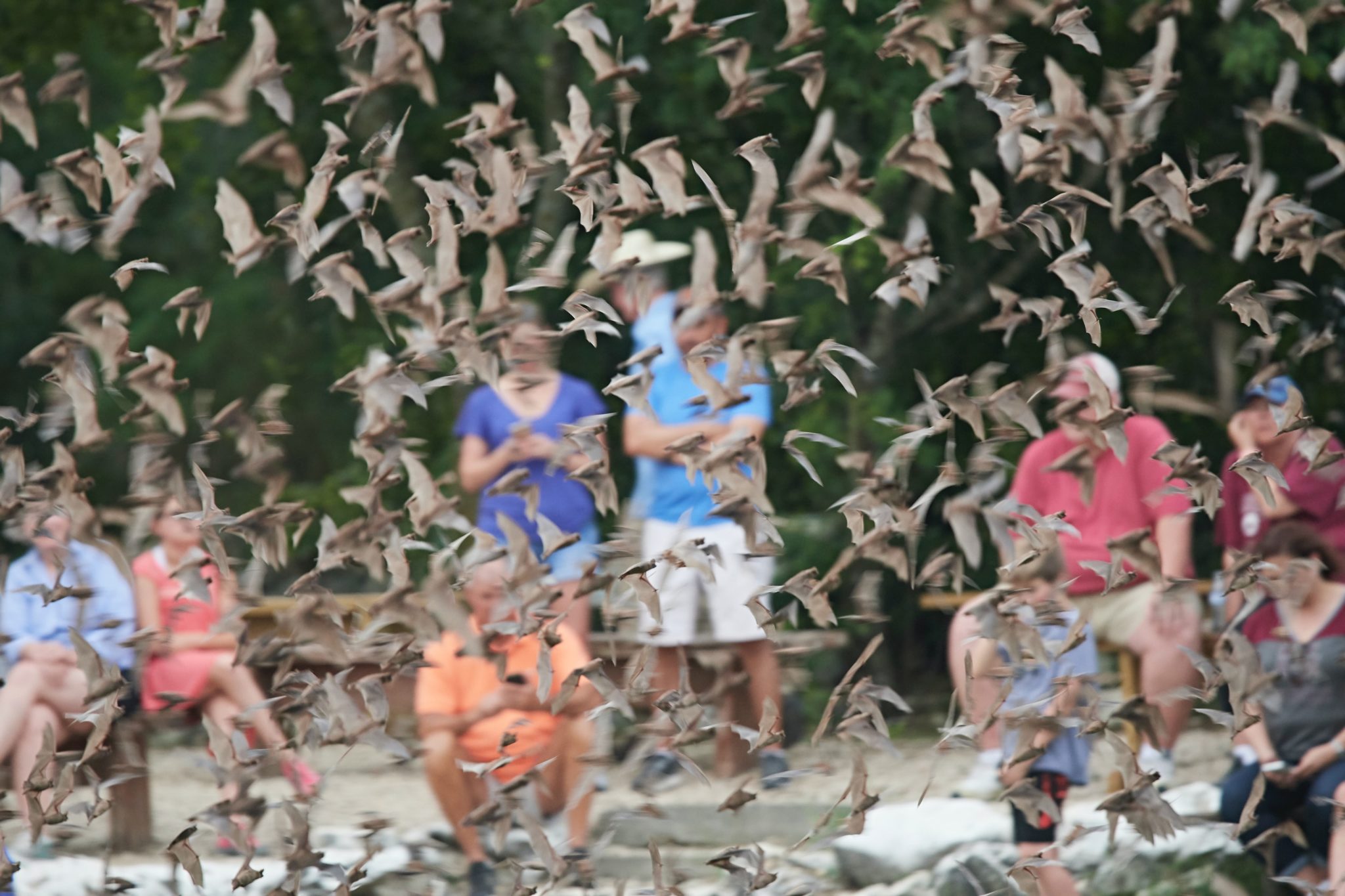
No one knows yet just how many bats were killed by the frigid conditions of [February’s] disastrous winter storm in Texas. Reports popped up across the state about thousands of the winged mammals found either dead or dying. The hardest-hit species appears to have been Mexican free-tailed bats, migrants better suited for warmer climates, as well as some species of yellow bats. But we may not know the full scope of the death toll for quite some time, if we ever do—partly because of a quirk in bat physiology.
“Bats have tendons attached to their claws such that just by hanging weight on them, it locks them in place,” says Merlin Tuttle, a biologist and executive director of Austin-based Merlin Tuttle’s Bat Conservation. “A bat once it dies may continue to cling to its perch for days or even weeks afterward because it takes a conscious effort for the bat to release…”
Calling All Birders: U.S. Fish & Wildlife Service and Texas Parks & Wildlife Department Need Citizen Scientists
News Release by U.S. Fish & Wildlife Service and Texas Parks & Wildlife Department
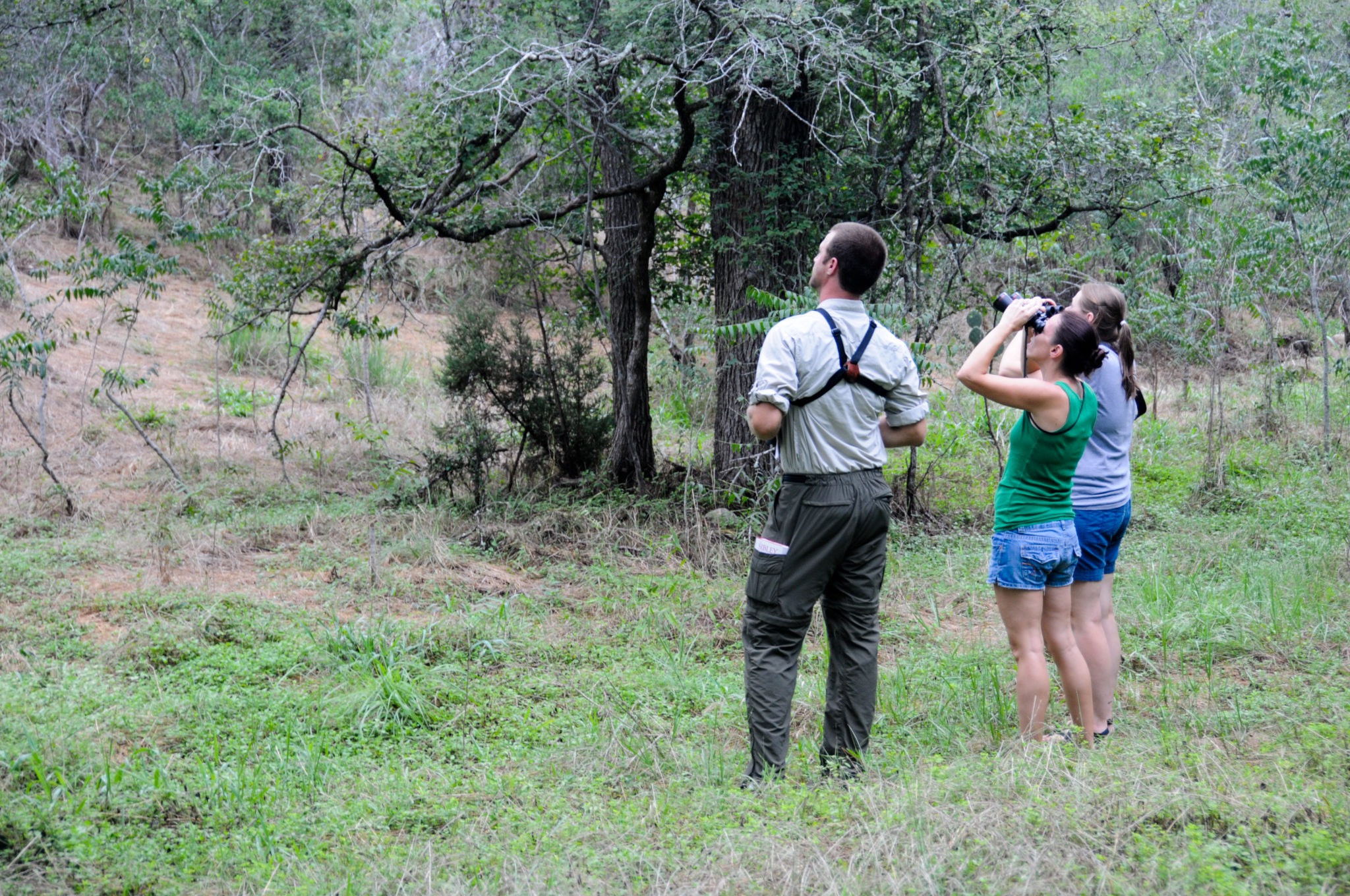
The U.S. Fish and Wildlife Service and the Texas Parks and Wildlife Department are asking citizen scientists to help monitor black-capped vireos from April 10th to July 1 at Inks Lake State Park and Lost Maples State Natural Area in Texas.
The previously endangered black-capped vireo has made a remarkable comeback thanks to the efforts of several conservation partners, which led to its removal from the Endangered Species List in 2018. When the black-capped vireo was listed, only 350 birds were known, but by 2018 the population was estimated at 14,000. Now, it is important to track the species’ progress to ensure it continues to show improvements. The Endangered Species Act requires monitoring of species that were delisted due to recovery for at least 5 years.
Learn more about monitoring methods and contact information by following the link below…
Prevent the Spread of Oak Wilt in Texas this Spring
Article by Leighton Chachere with Texas A&M AgriLife
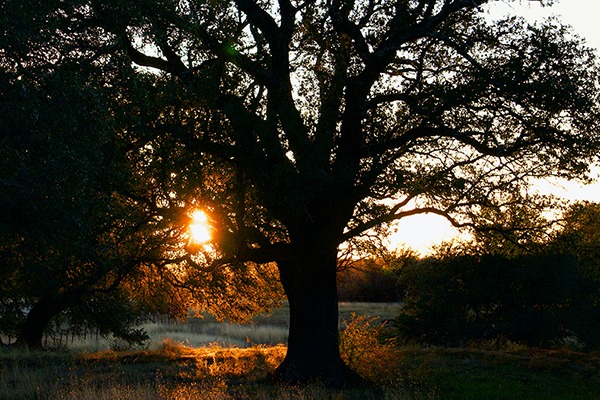
Oak wilt is one of the most destructive tree diseases in the U.S., killing millions of trees in 76 counties of Central, North and West Texas. Texas A&M Forest Service urges Texans to help stop the spread of oak wilt by avoiding pruning or wounding oak trees through June.
“This native fungus has been affecting oaks for decades in Texas; prevention and early detection are vital to stop the spread,” said Texas A&M Forest Service regional forest health coordinator, Demian Gomez.
Oak wilt spreads easiest between February and June because of high fungal mat production, high insect populations and the high susceptibility to disease for oaks.In the spring, red oaks that died of the disease last summer and fall may produce spore mats under the bark. With a fruity smell, these mats attract small, sap-feeding beetles that can later fly to a fresh wound of any oak tree and infect it, starting a new oak wilt center…
Back to TopBack to Top
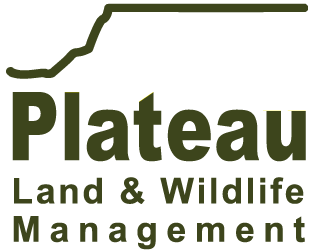







Sorry, the comment form is closed at this time.